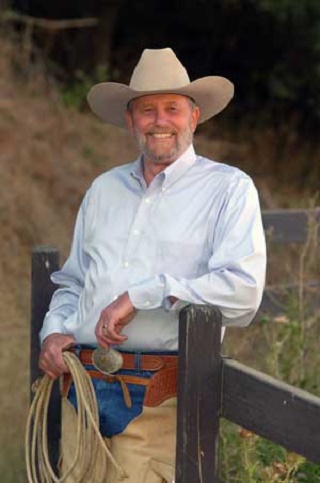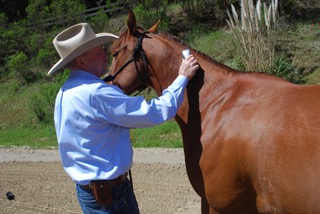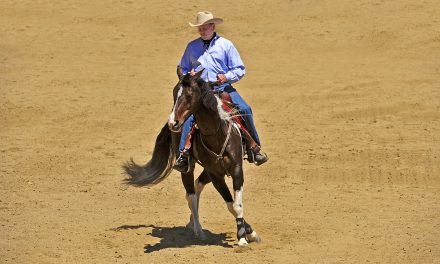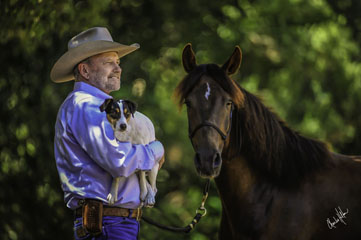
It is good to set goals for our horses and if one of your goals is to take your horse to a show, this article will help you develop a plan. There are a lot of steps between setting the goal and accomplishing it. What I like to do in training a horse is to have a training program planned before I start. It is good to have a weekly, three-month, 6-month and yearly road map. I allow as much time as is needed for each step working with that particular horse. For example, if I start a horse under saddle, normally in about three months, the horse will be 75% to 80% finished. After three months, I can walk, trot and canter, take the horse out on the trail and have relatively good control of the hind quarters and shoulders. The horse is starting to move off the outside rein, move off my leg and has somewhat accepted the bit. The horse is progressing and I am moving toward meeting my goal. There are a lot of steps to get the horse to this place.
In my training program, or any good training program, when a horse comes in there are certain steps that we begin with. As the horse progresses, we build on those steps. We start with small steps and when those are mastered, we build on them to increase learning. When young horses come in for schooling, they all have to go through our leading program. They must learn to be civilized, have manners and respect the trainer’s space. These are some building blocks or steps toward the goal of having a nice riding horse. All of our horses go through de-spooking; we work with the emotions so they learn to be calm. When we go to a show, we know our horses will handle the stress and pressure.
Another part of my training program is teaching the horse to respond to a forward cue, not only on the ground but in the saddle. Another part of our program is to get the horse to accept the saddle and make sure the horse is comfortable. This may sound easy but we had a horse come in not long ago that we worked with over thirty days before the horse would accept the saddle, be comfortable with it and not buck. Every day we put the saddle on the horse and it was not comfortable with it. Each day it got better and better but it was 45 days before we could saddle that horse and lead it out without the horse over reacting negatively. Each step takes time and some steps may take longer than we expect.
Another building block is to get a horse to accept a bit. This means not only bridling the horse but getting the horse to accept being bridled and start learning to give to pressure, to not resist but to yield to it. We teach the horse to follow its nose. In other words, when I pick up the right rein I want my horse to yield his nose and follow the direction I have asked for. The horse also needs to move off the outside rein; if I put the left rein on the horse’s neck the horse needs to move off the rein and go right in the direction I want it to go.
The learning blocks continue to build until the horse has a basic understanding and we have a better trained horse. This is true not only physically but emotionally and mentally, as a well-trained horse will start checking in with us to see what we want to do next. Sometimes in training a horse, I think of a pyramid, the top being my goal and the foundation in three parts. One is the mental part of the horse, another is the emotional part and the final part is the physical control of the horse. Do we have physical control of the horse? Can we stop and ask the horse to back up, go right or left? Do we have control when asking the horse to go into a stall, a trailer or a wash rack? That is the physical training. The emotional training is dealt with when I put pressure on a horse and the horse doesn’t strike out, kick or rear. Those are all part of the flight instinct and what we are trying to do is eliminate all that behavior as much as possible to create a safe horse. Mentally, I want my horse to start thinking about what is next, what I call business ears. When I am riding a horse and I have his ears on me working back and forth, back and forth, he is looking for the next direction. This means the horse is ready for the next cue telling him what I would like him to do. This is what we want our horse to do. When we get into a situation like a horse show, we want the horse will focus on us and not everything else that is going on.
When I have a client, who is planning on showing, I like to take the horse to several shows and just school him. Every horse is different and the horse may only need to go to a couple of shows before it will be fine and then we can show. Ideally what we like to do is take the horse the year before so that by the time we are ready to show, the horse is ready to be shown and is not concerned with trucks, trailers and the activity at a show. This is another building block. A goal is important but it requires a game plan. Many people have a goal but do not have a training plan. If your goal is to trail ride, you don’t want the horse bolting, nervous, jigging back home or barn sour. If you are having those problems, you have tried to do the goal first, without the building blocks of the training program.
I mentioned earlier the horse that was so difficult to get under saddle. This has been a tough horse. This horse has been here four months and it could not lunge without pulling out through the shoulders, it was rude and belligerent, it was difficult getting the horse to accept shots, and if touched on the side it would strike out. Now the horse is fine; he is like a totally different horse. It took us awhile to get through the building blocks to this point. And now, because we took the time to go through the steps, on the first ride out of the round pen we went all around the ranch and then into the arena. The owner’s goal for this horse is to show and participate in eventing. To do this, the horse must be able to accept pressures. Now the horse is willing, walks, trots, canters and is accepting of the rider. If we had pushed this horse too fast, he might have started baulking, bucking or blowing up in general. These types of negative experiences cost training time as we have to go back to deal with the issues.
You need to consider these things. Set your goal and decide what steps it will take to get your horse there. You need to think about what you need from your horse, what he needs to be able to do, in order to accomplish the goal. If I want a reining horse, the horse has to learn certain cues and I need to determine the which steps are needed to get the horse to learn those cues. You can learn some of these steps from two books I have written, Building Your Dream Horse and Starting Baby Jaz which is a colt starting book but it is also a great book for learning how to school your horse. Some of my DVDs are great for teaching basic commands and I am always available to answer questions.




